Maintaining caliper brakes is a question of regularly checking the action of the brake lever. If you have to pull it too far before the brake bites, the brake needs adjusting. Check the brake pads for wear and alignment, and ensure that they contact the braking surface of the rims simultaneously.
How far the lever has to be pulled before the brake comes on depends on the rider. People with smaller hands may prefer more travel in the lever before the brake bites, because they will pull with more strength the closer the lever is to the handlebar.
Apart from their quick releases, all dual-pivot caliper brakes (such as the Shimano brakes shown below) work in the same way, regardless of the manufacturer. This means that you should be able to apply these steps to your bike, whatever its brakes.
Tools needed:
- Needle-nose pliers
- Full set of Allen keys or Allen key multi-tool
Parts of a Caliper brake
Image (right) shows:
Travel adjuster, spring, and washer; Brake shoe and pad; etc.
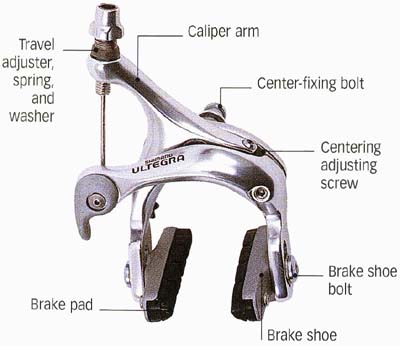

Adjusting a caliper brake
1. Periodically check for pad wear. If the pads are wearing down toward half their original depth, they must be replaced.
Undo the Allen key pad retainer and push out the pad. If the pad and shoe are a complete piece, replace the whole unit, releasing the old pad and fitting the new one with a 5mm Allen key.
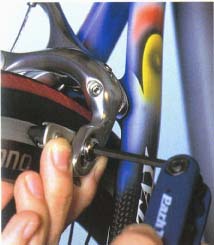
2 . Adjust the brake pads so they are directly in line with the braking surface of the rim.
- Release the 5mm Allen bolt on the pad and line the pad up with the braking surface.
- Look for pad wear at this point. Pads that have been set too low will develop a lip and will need to be replaced.
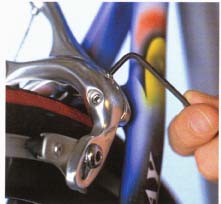
3. Pull the brake on with the brake lever and check to see if both pads simultaneously come in contact with the braking surface on the rim of the wheel.
- Make sure that both sides are working together by turning an adjustment screw on the side of the caliper with an Allen key. This process is called “centering” the brakes.
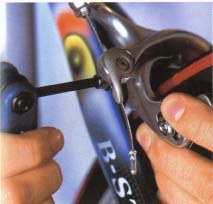
4. Adjust the brake travel if you have to pull the brake lever back a long way toward the handlebar before the wheel stops moving.
- Undo the cable-fixing bolt and squeeze the sides of the caliper until the pads nearly touch the rim. The brake cable will then move through the fixing bolt.
- Tighten the bolt and release the caliper.

Using quick-release mechanisms
1. Use a quick-release mechanism when the adjusted brake pads are so close to the rim that it is impossible to remove the wheel. Campagnolo and Shimano caliper brakes are equipped with different quick-release systems.
- Lift the small lever on the cable-fixing bolt to make Shimano caliper brake pads move away from the rim. After replacing the wheel, lower the lever.
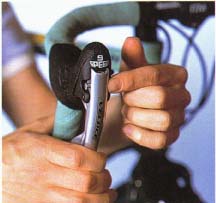
2. Press the small button at the side of the brake lever to move Campagnolo caliper brake pads away from the rim.
- Restore the pads to their original position by pulling the brake lever toward the handlebar until the brakes are on and then push the small button back.